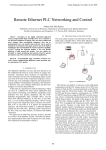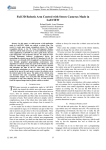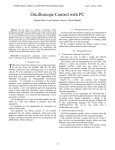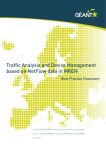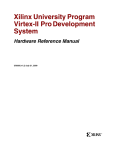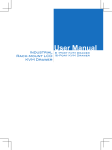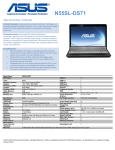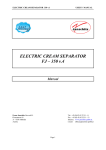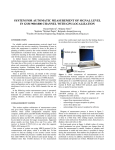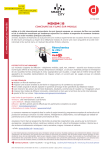Download TELFOR 2006
Transcript
17th Telecommunications forum TELFOR 2009 Serbia, Belgrade, November 24-26, 2009. VIRTEX II Timing-Simulation vs Reality Silvana POPESCU, Aurel GONTEAN High-speed SelectMAP FPGA configuration from Platform Flash In-System Programmable Configuration PROM; Support for ―Golden‖ and ―User‖ FPGA configuration bitstreams; On-board 10/100 Ethernet PHY device; Silicon Serial Number for unique board identification; RS-232 DB9 serial port; Two PS-2 serial ports; Four LEDs connected to Virtex-II Pro I/O pins; Four switches connected to Virtex-II Pro I/O pins; Five push buttons connected to Virtex-II Pro I/O pins; Six expansion connectors joined to 80 Virtex-II Pro I/O pins with over-voltage protection; High-speed expansion connector joined to 40 Virtex-II Pro I/O pins that can be used differentially or single ended; AC-97 audio CODEC with audio amplifier and speaker/headphone output and line level output; Microphone and line level audio input; On-board XSGA output, up to 1200 x 1600 at 70 Hz refresh; Abstract — The goal of this paper is understanding the performance capability of a modern FPGA in a post-layout simulator using a typical design. For this, an eight-phase generator was used as a test circuit and the delays between the outputs have been evaluated and corrected. Keywords — FPGA, rise time, simulation, VHDL. I. INTRODUCTION (Field-Programmable Gate Array) is an manufacturing. FPGAs contain programmable logic components called logic blocks and a hierarchy of reconfigurable interconnects that allows the blocks to be wired together. To define its behavior, the FPGA is programmed generally using a hardware description language (HDL). The most common language is VHDL (VHSIC – Very High Speed Integrated Circuits Hardware Description Language). VHDL is used for two different goals: simulation of electronic designs and synthesis of such designs. Synthesis is a process where a VHDL is compiled and mapped into an implementation technology such as a FPGA. Also, VHDL allows the description of a concurrent system unlike some programs in which the code run sequentially[1]. A FPGA II. HARDWARE AND SOFTWARE RESOURCES A. Virtex II Board The Virtex-II Pro Development System provides an advanced hardware platform that consists of a high performance Virtex-II Pro Platform FPGA surrounded by a comprehensive collection of peripherial components that can be used to create a complex system and to demonstrate the capabilities of the Virtex-II Pro Platform FPGA. Based on the Virtex-II Pro FPGA, the board can function as a digital design trainer, a microprocessor development system or a host for embedded processor cores and complex digital systems. Features of Virtex-II board: Virtex-II Pro FPGA with PowerPC 405 cores; Up to 2 GB of Double Data Rate (DDR) SDRAM; System AC controller and Type II CompactFlash connector for FPGA configuration and data storage; Embedded Platform Cable USB configuration port; Fig. 1. Virtex-II Board Three Serial ATA ports, two Host ports and one Target port; Off-board expansion MGT link, with user-supplied clock; 100 MHz system clock, 75 MHz SATA clock; Provision for user-supplied clock; S. P. - PhD student, Faculty of Electronics and Telecommunication, ―Politehnica‖ University of Timisoara, Romania (phone: +4-0724214627; e-mail: [email protected]). A. G. – Applied Electronics Departament, Faculty of Electronics and Telecommunications , ―Politehnica‖ University of Timisoara, Romania; (phone: +4-0745119858; e-mail: [email protected]). 755 entity 8phase is port( clk:in std_logic; reset, start. restart: in std_logic; OUT: out std_logic_vector(1 to 8)); End 8phase; On-board power supplies; Power-on reset circuitry; PowerPC 405 reset circuitry[2]. B. Virtex-II Pro Family FPGA The Virtex-II Pro/Virtex-II Pro X family is the first FPGA family to incorporate both serial transceiver technology and a hard processor core within a generalpurpose FPGA device. This is significant for new highbandwidth embedded processing applications such as packet processing, where both high device I/O bandwidth and high performance processor cores are needed together. The Virtex-II Pro/Virtex-II Pro X family marks the first paradigm change from programmable logic to programmable systems, with profound implications for leading-edge system architectures in networking applications, deeply embedded systems, and digital signal processing systems. It allows custom user-defined system architectures to be synthesized, next-generation connectivity standards to be seamlessly bridged, and complex hardware and software systems to be codeveloped rapidly with insystem debug at system speeds. Together, these capabilities usher in the next programmable logic revolution[3]. architecture 8phase_arch of 8phase is signal R_W: std_logic_vector(1 to 8); signal Aux: std_logic; begin process(clk, R_W) begin if (clk‘event and clk=‘1‘) then if (reset=‘1‘) then Aux <= ‗1‘; R_W <= (‗0‘,‘0‘,‘0‘,‘0‘,‘0‘,‘0‘,‘0‘,‘0‘); elsif ((R_W=(‗0‘,‘0‘,‘0‘,‘0‘,‘0‘,‘0‘,‘0‘,‘0‘)) or (restart=‘1‘)) then Aux <= ‗1‘; R_W <= (‗1‘,‘0‘,‘0‘,‘0‘,‘0‘,‘0‘,‘0‘,‘0‘); elsif (start=‘1‘) then Aux <= not Aux; if (Aux=‘0‘) then R_W <= R_W(8)&R_W(1 to 7); end if; end if; end if; OUT <= not R_W; end process; end 8phase_arch; C. Xilinx Web Pack ISE ISE WebPACK from Xilinx is a design software for FPGA design solution for Linux, Windows XP and Windows Vista. ISE WebPACK is used for FPGA and CPLD design offering HDL synthesis and simulation, implementation, device fitting, and JTAG programming. R_W is an internal active-high signal vector, used for reading and writing what eventually becomes the circuit‘s output. This signal is inverted to obtain the required active-low output signal vector. Aux is an auxiliary state bit to keep track of the two states within each phase. The OUT[i] and Aux signals are all outputs from the flip-flops clocked by the same clock clk[4]. This design is tested in simulation, first behavioral and then post-routed. III. DESIGN IMPLEMENTATION AND TESTING In order to verify the limits of the ISE Web Pack Suite, the eight-phase generator has been simulated, implemented and tested. A. Eight-phase Waveform Generator The eight-phase generator is an application of shift registers in ring counters. A shift register is a cascade of flip-flops, all sharing the same clock which have their inputs and outputs connected together, resulting in a circuit that shifts by one position the information stored in it at every transition of the clock input. Ring counters are implemented using shift registers so that the output of the last register is fed to the input of the first register. Figure 3 illustrates a ring counter on 8 bits. B. Behavioral Simulation The behavioral simulation is used to test the design functionality. The behavioral simulation is illustrated in fig.3. Signal clk is the clock used in the application of the eight-phase generator, signals start, restart and reset are the input signals and the OUT[i] signals are active low-phase outputs[5]. The signals in the selected aria are zoomed and shown in fig.4. As expected, fig.4. demonstrates that the behavioral simulation does not point out any delays. C. Post-Route Simulation Unlike the behavioral simulation, in the post-route simulation, the delays became noticeable. The encirclements from fig.5 are the delays introduced by the post-route simulation. One of these delays is shown in fig.6, namely the delay between the third and the fourth signal. Fig.2. A 8 bits ring counter The VHDL program of the eight-phase waveform generator is shown below. 756 Fig.3. Behavioral Simulation Fig.4. Zoomed Behavioral Simulation Fig.5. The Post-Route Simulation Fig.6. Zoomed delayed detail between out[3] and out[4] 757 The delays between every two consecutive signals are listed in Table 1. E. Correcting the Measured Rise Time Rise time refers to the time required for a signal to change from a specificed low value(10%) to a specified high value(90%). The relationship between the rise time and the bandwidth of a digital oscilloscope is given by: TABLE 1: DELAYS BETWEEN CONSECUTIVE SIGNALS. Signals 1_2 2_3 3_4 4_5 5_6 6_7 7_8 8_1 Delays [ps] 238 527 104 376 117 208 106 176 The measured rise time is commonly related to the oscilloscope rise time and the real rise time using the formula: The relationship (2) is useble only if tmeasured ≥ tr [7],[8]. Otherwise, the errors make the correction useless. The oscilloscope rise time is, form its tehnical manual, 400ps.[6] D. Experimental Results Experimental results were acquired with a LeCroy WaveSurfer Xs Series Oscilloscope, a high performance digital oscilloscope. In order to obtain results, the eight signals were routed to the two 40-pin right angle connectors[6]. The first measurement was with the eight signals routed to the left expansion connector and the second measurement was with the signals routed to the right connector. Fig.7 illustrates the delay between the third and the fouth signal. The delay is estimated with the skew function of the digital oscilloscope. The skew function calculates the delay between two signals in the following way: time of clock1 edge minus time of the nearest clock2 edge which represents exactly the delay between the two signals. The real rise time is shown in Tabel 3. TABLE 3: REAL RISE TIME Delay Signal 3_4 5_6 Measured rise time [ps] 606 438 Oscilloscope rise time [ps] 400 400 Real rise time [ps] 456 178 IV. CONCLUSION In managing short times, extra care should be taken. The oscilloscope‘s bandwidth should be at least five times higher than the fastest clock rate in the design. Otherwise, in order to make accurate edge-speed measurements on the signals, you will need to determine the maximum practical frequency present in the signal. REFERENCES [1] [2] [3] [4] Fig.7. The delay between the third and the fourth signal. [5] [6] Computing all the delays between every two consecutive signals, Table 2 illustrates some of the most effective delays. [7] [8] TABLE 2: DELAYS AT THE TWO 40-PIN CONNECTORS. Delay Signal 3_4 5_6 Post-route simulation [ps] 104 117 1st 40-pin connector [ps] 606 438 2nd 40-pin connector [ps] 451 1051 758 S. Popescu, A.Gontean, I.Lie, ―Comparing FPGA behavioral simulation, post-routed simulation with real-life experiments‖— Accepted for publication at SIITME2009. XUP Virtex-II Pro Development System, User Manual, Xilinx, 2009. Virtex II Pro User Guide Family, Xilinx, 2004 J.Wakerly – Digital Design.Principles and Practices, Third Edition, 2006. ISE 10.1 Quick Start Tutorial, Xilinx, 2008 LeCroy WaveSurfer, Xs Series Oscilloscope Operator’s Manual, 2008 Relating wideband DSO rise time to bandwidth: Lose the 0.35, Agilent 55W-18024-2, 2009 Understanding Oscilloscope Bandwidth, Rise Time and Signal Fidelity, Tektronix, 2002.




